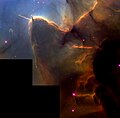Trifidnebel
| Emissionsnebel | |
|---|---|
| Trifidnebel | |
 | |
| Trifidnebel, aufgenommen am Palomar-Observatorium; der Bereich der Detailvergrößerung ist eingezeichnet. | |
| AladinLite | |
| Sternbild | Schütze |
| Position Äquinoktium: J2000.0, Epoche: J2000.0 | |
| Rektaszension | 18h 02m 42s[1] |
| Deklination | −22° 58′ 18″[1] |
| Erscheinungsbild | |
| Scheinbare Helligkeit (visuell) | 6,3 mag[1] |
| Scheinbare Helligkeit (B-Band) | 6,75 mag[1] |
| Winkelausdehnung | 28,0'[2] |
| Ionisierende Quelle | |
| Bezeichnung | HD 164492 |
| Typ | Stern |
| Physikalische Daten | |
| Zugehörigkeit | Milchstraße |
| Rotverschiebung | −0,000007 |
| Radialgeschwindigkeit | −2,13 km/s |
| Entfernung[2] | 5200 Lj (1600 pc) |
| Geschichte | |
| Entdeckung | Charles Messier |
| Datum der Entdeckung | 5. Juni 1764[3] |
| Katalogbezeichnungen | |
| M 20 • NGC 6514 • OCISM 2 | |
Der Trifidnebel (auch als Messier 20 oder NGC 6514 bezeichnet) ist ein Emissions- und Reflexionsnebel im Sternbild Schütze. Der Name entstammt dem lateinischen Wort trifidus „dreigeteilt, dreigespalten“, da eine dunkle Staubwolke (Barnard 85) den Nebel dreiteilt.
- Infrarotaufnahme des Spitzer-Weltraumteleskops
- Detail mit Jets, aufgenommen vom Hubble-Weltraumteleskop
Der Trifidnebel ist ein Ort der Sternentstehung (H-II-Gebiet) mit einer scheinbaren Helligkeit von +9,0 mag und einer Flächenausdehnung von 28' × 28'. Die Ionisation des Hauptnebels erfolgt durch den heißen Stern HD 164492, der zum O7-Typ gehört. Im Inneren des Nebels verstecken sich noch einige nur im Infraroten sichtbare massereiche Protosterne. Die Entfernung des Trifidnebels von der Erde beträgt etwa 5200 Lichtjahre. Wegen seiner südlichen Position ist der Nebel in Mitteleuropa nicht besonders gut zu beobachten. Auf der Detailaufnahme sind Jets sichtbar, wie sie sich bei der Sternentstehung entwickeln.
Siehe auch
- Messier-Katalog
- Liste der diffusen Nebel
Literatur
- König, Michael & Binnewies, Stefan (2023): Bildatlas der Sternhaufen & Nebel, Stuttgart: Kosmos, S. 146
Weblinks
- Spitzer-Observatorium/M20 ( vom 9. Mai 2008 im Internet Archive)
- ESO: Dreifacher Trifidnebel +Fotos&Animation – 26. August 2009
- ESO: Interaktives Vergleichsbild des Trifidnebels im sichtbaren und infraroten Licht 4. Februar 2015
Einzelnachweise
Auf dieser Seite verwendete Medien
Bildtafel der 110 Messier-Objekte. Diese Datei wird in der w:de:Template:Navigationsleiste Messierobjekte als Imagemap genutzt. Sie darf daher nicht durch eine andere Version überschrieben werden!
ABOUT THIS IMAGE:
This NASA Hubble Space Telescope image of the Trifid Nebula reveals a stellar nursery being torn apart by radiation from a nearby, massive star. The picture also provides a peek at embryonic stars forming within an ill-fated cloud of dust and gas, which is destined to be eaten away by the glare from the massive neighbor. This stellar activity is a beautiful example of how the life cycles of stars like our Sun is intimately connected with their more powerful siblings.
The Hubble image shows a small part of a dense cloud of dust and gas, a stellar nursery full of embryonic stars. This cloud is about 8 light-years away from the nebula's central star, which is beyond the top of this picture. Located about 9,000 light-years from Earth, the Trifid resides in the constellation Sagittarius.
A stellar jet [the thin, wispy object pointing to the upper left] protrudes from the head of a dense cloud and extends three-quarters of a light-year into the nebula. The jet's source is a very young stellar object that lies buried within the cloud. Jets such as this are the exhaust gases of star formation. Radiation from the massive star at the center of the nebula is making the gas in the jet glow, just as it causes the rest of the nebula to glow.
The jet in the Trifid is a "ticker tape," telling the history of one particular young stellar object that is continuing to grow as its gravity draws in gas from its surroundings. But this particular ticker tape will not run for much longer. Within the next 10,000 years the glare from the central, massive star will continue to erode the nebula, overrunning the forming star, and bringing its growth to an abrupt and possibly premature end.
Another nearby star may have already faced this fate. The Hubble picture shows a "stalk" [the finger-like object] pointing from the head of the dense cloud directly toward the star that powers the Trifid. This stalk is a prominent example of the evaporating gaseous globules, or "EGGs," that were seen previously in the Eagle Nebula, another star-forming region photographed by Hubble. The stalk has survived because at its tip there is a knot of gas that is dense enough to resist being eaten away by the powerful radiation.
Reflected starlight at the tip of the EGG may be due to light from the Trifid's central star, or from a young stellar object buried within the EGG. Similarly, a tiny spike of emission pointing outward from the EGG looks like a small stellar jet. Hubble astronomers are tentatively interpreting this jet as the last gasp from a star that was cut off from its supply lines 100,000 years ago.
The images were taken Sept. 8, 1997 through filters that isolate emission from hydrogen atoms, ionized sulfur atoms, and doubly ionized oxygen atoms. The images were combined in a single color composite picture. While the resulting picture is not true color, it is suggestive of what a human eye might see.
Object Name: Trifid Nebula
Image Type: Astronomical
Credit: NASA and Jeff Hester (Arizona State University)Autor/Urheber: Die Autorenschaft wurde nicht in einer maschinell lesbaren Form angegeben. Es wird Med als Autor angenommen (basierend auf den Rechteinhaber-Angaben)., Lizenz: CC BY 2.5
Image of the Trifid Nebula in Infrared at 3.6 (blue), 8.0 (green) and 24 (red) µm. The image has been made by myself (Médéric Boquien) from the public image archive of the Spitzer Space Telescope (courtesy NASA/JPL-Caltech)








